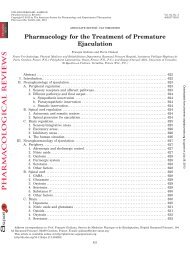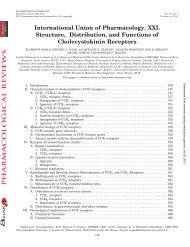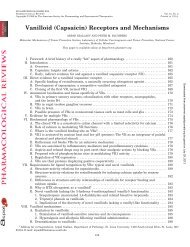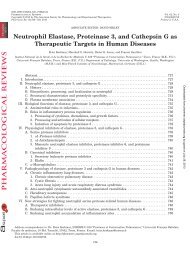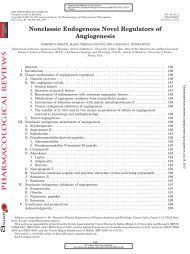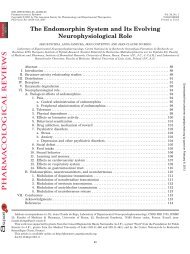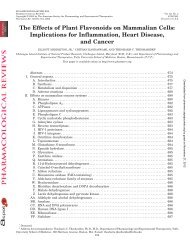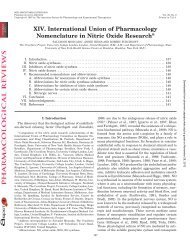Opioids, Reward and Addiction: An Encounter of Biology ...
Opioids, Reward and Addiction: An Encounter of Biology ...
Opioids, Reward and Addiction: An Encounter of Biology ...
You also want an ePaper? Increase the reach of your titles
YUMPU automatically turns print PDFs into web optimized ePapers that Google loves.
Joshi, 1998). Place aversion induced by naltrexone in<br />
rats physically dependent on morphine appeared not to<br />
be associated with somatic signs <strong>of</strong> opioid withdrawal<br />
(Mucha, 1987). Indeed, in physically dependent rats,<br />
i.c.v. administration <strong>of</strong> methylnaloxonium induced a significant<br />
place aversion, whereas s.c. methylnaloxonium<br />
did not (H<strong>and</strong> et al., 1988). Conversely, withdrawal from<br />
chronic treatment with naltrexone actually appeared to<br />
enhance morphine’s properties to induce conditioned<br />
place preference (Bardo <strong>and</strong> Neisew<strong>and</strong>er, 1987).<br />
Research by Van der Kooy <strong>and</strong> colleagues has indicated<br />
a distinction between the place-conditioning effects<br />
<strong>of</strong> opioids in drug-naive <strong>and</strong> physically dependent<br />
animals. Briefly, morphine-induced place preference can<br />
be blocked by lesions <strong>of</strong> the tegmental pedunculopontine<br />
nucleus in drug-naive but not in physically dependent<br />
animals. In contrast, DA antagonists only abolished<br />
place preference (associated with relief <strong>of</strong> withdrawal) in<br />
physically dependent but not opioid-naive rats (Bechara<br />
<strong>and</strong> Van der Kooy, 1987; Bechara et al., 1992, 1995).<br />
These findings could account for the controversial results<br />
reported with respect to the role <strong>of</strong> mesolimbic DA<br />
in opioid place-conditioning (see VIII. <strong>Addiction</strong> <strong>and</strong> Endogenous<br />
<strong>Opioids</strong>), as this system might only come into<br />
play in the case <strong>of</strong> physical dependence. Interestingly, in<br />
the first report on morphine-induced place-conditioning<br />
that suggested an involvement <strong>of</strong> dopaminergic mechanisms<br />
in this phenomenon, rats physically dependent on<br />
morphine were used (Schwartz <strong>and</strong> Marchok, 1974). It<br />
has been suggested that even morphine administered<br />
intra-VTA (the effects <strong>of</strong> which are thought to be strictly<br />
dopaminergic) only induces DA-dependent place preference<br />
in physically dependent animals (Nader <strong>and</strong> Van<br />
der Kooy, 1997). The place preference induced by intra-<br />
VTA-administered morphine could, in drug-naive rats,<br />
be blocked by lesions <strong>of</strong> tegmental pedunculopontine<br />
nucleus, but not by treatment with a DA antagonist,<br />
suggesting a nondopaminergic substrate in the VTA associated<br />
with opioid-induced place-conditioning.<br />
Although some <strong>of</strong> these are centrally mediated, the<br />
somatic signs <strong>of</strong> opioid withdrawal have been shown not<br />
to be responsible for opioid withdrawal-induced place<br />
aversion (Mucha, 1987; H<strong>and</strong> et al., 1988). Thus, there<br />
has been some effort in finding the cerebral locus where<br />
this phenomenon might be mediated. Lesions <strong>of</strong> the<br />
dorsomedial amygdala, but not the NAC, were found to<br />
reduce the aversiveness <strong>of</strong> opioid withdrawal (Kelsey<br />
<strong>and</strong> Arnold, 1994). In view <strong>of</strong> the aforementioned studies<br />
by Van der Kooy <strong>and</strong> colleagues this is particularly<br />
interesting, since the dopaminergic cells in the VTA<br />
project to both NAC <strong>and</strong> amygdala. This suggests that<br />
the opioid-withdrawal associated morphine-induced<br />
place preference involves DA in the amygdala. However,<br />
Koob <strong>and</strong> colleagues demonstrated place aversions in<br />
physically dependent rats induced by methylnaloxone<br />
injections into the NAC, periaqueductal gray, <strong>and</strong> medial<br />
thalamus. Of these sites, the NAC was the most<br />
OPIOIDS, REWARD AND ADDICTION 371<br />
sensitive site (Koob et al., 1989b; Stinus et al., 1990).<br />
Other studies have also shown that the mesolimbic DA<br />
system, as well as -opioid receptors, are involved in the<br />
aversiveness <strong>of</strong> morphine-withdrawal (Spanagel et al.,<br />
1994). With respect to receptor types involved in opioid<br />
withdrawal-induced place aversion, alongside - <strong>and</strong><br />
-opioid receptors, receptors were also involved. Beside<br />
naloxone, the -opioid antagonists naltrindole <strong>and</strong> naltriben<br />
were capable <strong>of</strong> inducing place aversion in physically<br />
dependent rats (Funada et al., 1996).<br />
Intermittent pretreatment with morphine has been<br />
shown to increase the ability <strong>of</strong> morphine <strong>and</strong> cocaine,<br />
but not <strong>of</strong> the selective DA reuptake inhibitor GBR-<br />
12783 to induce place preference (Lett, 1989; Gaiardi et<br />
al., 1991; Shippenberg <strong>and</strong> Heidbreder, 1995a; Spanagel,<br />
1995; Shippenberg et al., 1996a, 1998; Greksch et<br />
al., 1998; Le Pen et al., 1998) to induce place preference.<br />
This indicates that morphine-induced behavioral sensitization,<br />
defined as an increased behavioral response to<br />
a given dose <strong>of</strong> drug or a response <strong>of</strong> a similar magnitude<br />
upon treatment with a lower dose <strong>of</strong> drug (Stewart <strong>and</strong><br />
Badiani, 1993), is not only apparent with respect to its<br />
locomotor effects (Babbini <strong>and</strong> Davis, 1972; Babbini et<br />
al., 1975; V<strong>and</strong>erschuren et al., 1997), but also its placeconditioning<br />
effects. Both morphine-induced locomotor<br />
sensitization <strong>and</strong> the sensitization to the place-conditioning<br />
effects are long-term phenomena, since sensitization<br />
<strong>of</strong> both can be found until at least 3 weeks posttreatment<br />
(Babbini <strong>and</strong> Davis, 1972; Babbini et al.,<br />
1975; Gaiardi et al., 1991; Shippenberg et al., 1996a;<br />
V<strong>and</strong>erschuren et al., 1997).<br />
In conclusion, by pretreating animals with opioids<br />
before place-conditioning, central systems responsible<br />
for the effects <strong>of</strong> opioid-induced place-conditioning can<br />
be modulated in such ways that animals will become<br />
more or less sensitive to the effects <strong>of</strong> opioids on placeconditioning.<br />
There is far more experimental evidence<br />
for the occurrence <strong>of</strong> sensitization than for opioidinduced<br />
tolerance to the effects <strong>of</strong> opioids on placeconditioning.<br />
In addition, if chronic stimulation <strong>of</strong> central<br />
opioid systems is ceased, the consequences <strong>of</strong> which<br />
can be enhanced by administration <strong>of</strong> an opioid antagonist,<br />
withdrawal-induced place aversion can be found.<br />
VI. Endogenous <strong>Opioids</strong> <strong>and</strong> Nonopioid<br />
Drugs <strong>of</strong> Abuse<br />
The discovery in the brain <strong>of</strong> opioid-binding sites <strong>and</strong><br />
endogenous morphine-like substances (Pert <strong>and</strong> Snyder,<br />
1973; Simon et al., 1973; Terenius, 1973; Hughes et al.,<br />
1975) has led to the hypothesis that opioid receptors<br />
may be sites where opioids agonists, such as morphine<br />
<strong>and</strong> heroin, induce, among others, opioid reinforcement<br />
<strong>and</strong> addiction. A role <strong>of</strong> endogenous opioids in the reinforcing<br />
<strong>and</strong> dependence-creating properties <strong>of</strong> opioids,<br />
but also <strong>of</strong> nonopioid drugs <strong>of</strong> abuse, has been proposed.<br />
In this section, the involvement <strong>of</strong> the endogenous opioids<br />
in reinforcement from <strong>and</strong> dependence on nonopioid



